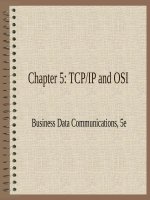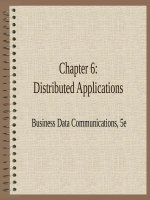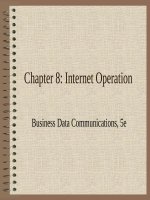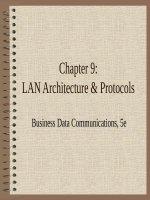Business data communications 5e by stallings chapter 17
Bạn đang xem bản rút gọn của tài liệu. Xem và tải ngay bản đầy đủ của tài liệu tại đây (239.17 KB, 25 trang )
Chapter 17:
Data Link Control
and Multiplexing
Business Data Communications, 5e
Flow Control
• Necessary when data is being sent faster
than it can be processed by receiver
• Computer to printer is typical setting
• Can also be from computer to computer,
when a processing program is limited in
capacity
Business Data Commun
ications, 5e
2
Error Correction
• Two types of errors
– Lost frame
– Damaged frame
• Automatic Repeat reQuest (ARQ)
–
–
–
–
Error detection
Positive acknowledgment
Retransmission after time-out
Negative acknowledgment and retransmission
Business Data Commun
ications, 5e
3
Data Link Control
• Specified flow and error control for
synchronous communication
• Data link module arranges data into
frames, supplemented by control bits
• Receiver checks control bits, if data is
intact, it strips them
Business Data Commun
ications, 5e
4
High-Level Data Link Control
• On transmitting side, HDLC receives data
from an application, and delivers it to the
receiver on the other side of the link
• On the receiving side, HDLC accepts the
data and delivers it to the higher level
application layer
• Both modules exchange control
information, encoded into a frame
Business Data Commun
ications, 5e
5
HDLC Frame Structure
•
•
•
•
Flag: 01111110, at start and
end
Address: secondary station (for
multidrop configurations)
Information: the data to be
transmitted
Frame check sequence: 16- or
32-bit CRC
• Control: purpose or
function of frame
– Information frames:
contain user data
– Supervisory frames:
flow/error control
(ACK/ARQ)
– Unnumbered frames:
variety of control
functions (see p.131)
Business Data Commun
ications, 5e
6
HDLC Operation
• Initialization: S-frames specify mode and
sequence numbers, U-frames acknowledge
• Data Transfer: I-frames exchange user
data, S-frames acknowledge and provide
flow/error control
• Disconnect: U-frames initiate and
acknowledge
Business Data Commun
ications, 5e
7
HDLC Examples
Business Data Commun
ications, 5e
8
Multiplexing
• Shared use of communication capacity
• Commonly used in long-haul communications,
on high-capacity fiber, coaxial, or microwave
links
• Multiplexer combines data from n input lines and
transmits over a higher-capacity data link
• Demultiplexer accepts multiplexed data stream,
separates the data according to channel, and
delivers them to the appropriate output lines.
Business Data Commun
ications, 5e
9
Multiplexing Diagram
Business Data Commun
ications, 5e
10
Motivations for Multiplexing
• The higher the data rate, the more costeffective the transmission facility
– cost per kbps declines with an increase in the
data rate of the transmission facility
– cost of transmission and receiving equipment,
per kbps, declines with increasing data rate.
• Most individual data communicating
devices require relatively modest data rate
support
Business Data Commun
ications, 5e
11
Frequency Division
Multiplexing (FDM)
• Requires analog signaling & transmission
• Total bandwidth = sum of input
bandwidths + guardbands
• Modulates signals so that each occupies a
different frequency band
• Standard for radio broadcasting, analog
telephone network, and television
(broadcast, cable, & satellite)
Business Data Commun
ications, 5e
12
Wavelength Division
Multiplexing
• Form of FDM used when multiple beams of light
at different frequencies are transmitted on the same
optical fiber
• Most WDM systems operate in the 1550-nm
range. In early systems, 200 MHz was allocated to
each channel, but today most WDM systems use
50-GHz spacing
• dense wavelength division multiplexing
(DWDM) connotes the use of more channels, more
closely spaced (≤200Ghz), than ordinary WDM
Business Data Commun
ications, 5e
13
FDM Example: ADSL
• ADSL uses frequency-division modulation
(FDM) to exploit the 1-MHz capacity of
twisted pair.
• Asymmetric because ADSL provides more
capacity downstream (from the carrier’s
central office to the customer’s site) than
upstream (from customer to carrier).
Business Data Commun
ications, 5e
14
3 Elements of ADSL Strategy
• Reserve lowest 25 kHz for voice, known as
POTS
• Use echo cancellation or FDM to allocate a
small upstream band and a larger
downstream band
• Use FDM within the upstream and
downstream bands, using “discrete
multitone”
Business Data Commun
ications, 5e
15
Echo Cancellation
• Entire frequency band for the upstream channel
overlaps the lower portion of the downstream
channel
• Advantages
– The higher the frequency, the greater the attenuation.
– More flexible for changing upstream capacity
• Disdvantages
– Need for echo cancellation logic on both ends of line
Business Data Commun
ications, 5e
16
Discrete Multitone (DMT)
• Uses multiple carrier signals at different
frequencies, sending some of the bits on each
channel.
• Transmission band (upstream or downstream) is
divided into a number of 4-kHz subchannels.
• Modem sends out test signals on each subchannel
to determine the signal to noise ratio; it then
assigns more bits to better quality channels and
fewer bits to poorer quality channels.
Business Data Commun
ications, 5e
17
Synchronous Time-Division
Multiplexing (TDM)
• Used in digital transmission
• Requires data rate of the medium to exceed data rate of
signals to be transmitted
• Signals “take turns” over medium
• Slices of data are organized into frames
• Used in the modern digital telephone system
– US, Canada, Japan: DS-0, DS-1 (T-1), DS-3 (T-3), ...
– Europe, elsewhere: E-1, E3, …
Business Data Commun
ications, 5e
18
Digital Carrier Systems
• Long-distance carrier system designed to
transmit voice signals over high-capacity
transmission links (e.g. optical fiber,
coaxial cable, and microwave)
• Evolution of these networks to digital
involved adoption of synchronous TDM
transmission structures
Business Data Commun
ications, 5e
19
DS-1 Transmission Format
• Multiplexes 24 channels
• Voice transmission
– Frame contains 8 bits per channel plus a framing bit for
24 × 8 + 1 = 193 bits
– Signal digitized with PCM at 8000 samples/second
– Data rate of 8000 × 193 = 1.544 Mbps
• Data transmission
– 23 channels of data are provided
– Last channel position reserved for special sync byte
• Mixed voice and data uses all 24 channels
Business Data Commun
ications, 5e
20
DS-1 Illustration
Business Data Commun
ications, 5e
21
T-1 Facilities
• Transmission facilities supporting DS-1
• Often used for leased dedicated
transmission between customer premises
–
–
–
–
–
Private voice networks
Private data network
Video teleconferencing
High-speed digital facsimile
Internet access
Business Data Commun
ications, 5e
22
SONET/SDH
• SONET (Synchronous Optical Network) is an
optical transmission interface proposed by
BellCore and standardized by ANSI.
• Synchronous Digital Hierarchy (SDH), a
compatible version, has been published by ITU-T
• Specifications for taking advantage of the highspeed digital transmission capability of optical
fiber.
Business Data Commun
ications, 5e
23
SONET/SDH Signal Hierarchy
Business Data Commun
ications, 5e
24
STS-1 and STM-N Frames
Business Data Commun
ications, 5e
25









